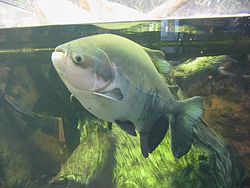Seeding with the fishes
 Seed plants rely heavily on animals to disperse their seeds. These dispersers are crucial to the survival and fitness of plants – the pattern of dispersal can determine survivorship at the individual level, population dynamics at the community level and eventual evolution at the species level. From bats to mice to robins and monkeys, mammals and birds make up the majority of these seed dispersers by feeding on plant parts and then depositing them, out the other end, somewhere else.
Seed plants rely heavily on animals to disperse their seeds. These dispersers are crucial to the survival and fitness of plants – the pattern of dispersal can determine survivorship at the individual level, population dynamics at the community level and eventual evolution at the species level. From bats to mice to robins and monkeys, mammals and birds make up the majority of these seed dispersers by feeding on plant parts and then depositing them, out the other end, somewhere else.
But a new study in the journal Oecologia reminds us that there are some unlikely seed dispersers that can be pretty important as well: namely, fish.
Wait, you say. How can fish eat terrestrial plants? And when they “redistribute” the seeds, doesn’t that defeat the purpose since they’re underwater?
![]() Jill Anderson of Cornell and her colleagues solve these mysteries by exploring the natural history of freshwater fishes that live in the rivers and floodplains of South America. Some 200 species of fish on this continent move into temporarily flooded habitats during the flood season, where they feed on fruits dropped into the water from trees and shrubs. The researchers studied two species in the pacu family, both of which can grow to a massive 25 kg and more than three meters in length. Their results show that the fishes are in fact important seed dispersers, redistributing seeds from about 35 percent of the species in the area. The seeds deposited in the floodplain can germinate and grow after the floodwaters recede.
Jill Anderson of Cornell and her colleagues solve these mysteries by exploring the natural history of freshwater fishes that live in the rivers and floodplains of South America. Some 200 species of fish on this continent move into temporarily flooded habitats during the flood season, where they feed on fruits dropped into the water from trees and shrubs. The researchers studied two species in the pacu family, both of which can grow to a massive 25 kg and more than three meters in length. Their results show that the fishes are in fact important seed dispersers, redistributing seeds from about 35 percent of the species in the area. The seeds deposited in the floodplain can germinate and grow after the floodwaters recede.
The authors also note that larger fish are more effective seed dispersers, and that overfishing of the larger individuals could lead to reduced seed dispersal and changes in community dynamics.
Read more in the Oecologia paper (subscription only).
Anderson, J., Saldaña Rojas, J., & Flecker, A. (2009). High-quality seed dispersal by fruit-eating fishes in Amazonian floodplain habitats Oecologia DOI: 10.1007/s00442-009-1371-4